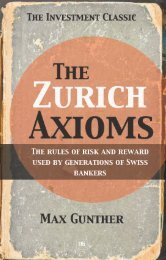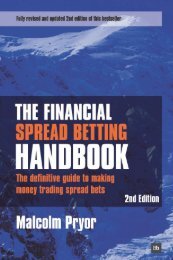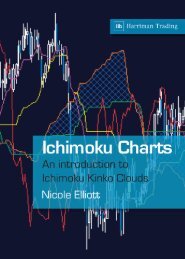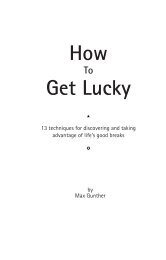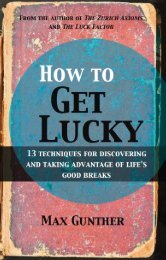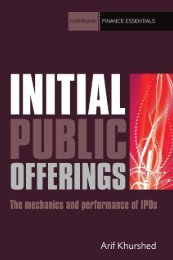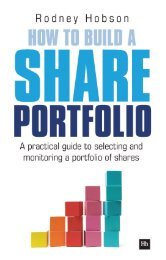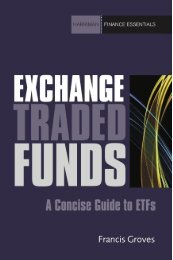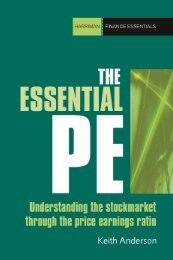Read a PDF Sample of Predatory Trading and ... - Harriman House
Read a PDF Sample of Predatory Trading and ... - Harriman House
Read a PDF Sample of Predatory Trading and ... - Harriman House
Create successful ePaper yourself
Turn your PDF publications into a flip-book with our unique Google optimized e-Paper software.
xxxxxxxxxxxx<br />
1
• • • • <strong>Sample</strong> • • • •
PREDATORY TRADING<br />
AND CROWDED EXITS<br />
NEW THINKING ON MARKET VOLATILITY<br />
BY JAMES CLUNIE
HARRIMAN HOUSE LTD<br />
3A Penns Road<br />
Petersfield<br />
Hampshire<br />
GU32 2EW<br />
GREAT BRITAIN<br />
Tel: +44 (0)1730 233870<br />
Email: enquiries@harriman-house.com<br />
Website: www.harriman-house.com<br />
First published in Great Britain in 2010<br />
Copyright © <strong>Harriman</strong> <strong>House</strong> Ltd<br />
The right <strong>of</strong> James Clunie to be identified as the author has been asserted<br />
in accordance with the Copyright, Design <strong>and</strong> Patents Act 1988.<br />
978-1-906659-05-9<br />
British Library Cataloguing in Publication Data<br />
A CIP catalogue record for this book can be obtained from the British Library.<br />
All rights reserved; no part <strong>of</strong> this publication may be reproduced, stored in a retrieval<br />
system, or transmitted in any form or by any means, electronic, mechanical,<br />
photocopying, recording, or otherwise without the prior written permission <strong>of</strong> the<br />
Publisher. This book may not be lent, resold, hired out or otherwise disposed <strong>of</strong> by way <strong>of</strong><br />
trade in any form <strong>of</strong> binding or cover other than that in which it is published without the<br />
prior written consent <strong>of</strong> the Publisher.<br />
No responsibility for loss occasioned to any person or corporate body acting or<br />
refraining to act as a result <strong>of</strong> reading material in this book can be accepted by the<br />
Publisher, by the Author, or by the employer <strong>of</strong> the Author.
Contents<br />
About the Author<br />
Acknowledgements<br />
Preface<br />
Introduction<br />
v<br />
vii<br />
ix<br />
xi<br />
Chapter 1: The Ecology <strong>of</strong> Markets 1<br />
Chapter 2: <strong>Predatory</strong> <strong>Trading</strong> 31<br />
Chapter 3: Crowded Exits 81<br />
Chapter 4: Stop Losses 103<br />
Chapter 5: Manipulation 135<br />
Chapter 6: Final Thoughts 177<br />
Appendix 1: The Market Model 185<br />
Appendix 2: Abnormal Returns 189<br />
Bibliography 193<br />
Index 203<br />
iii
About the Author<br />
James Clunie works at Scottish Widows Investment Partnership<br />
(SWIP), where he is responsible for managing a UK equity long-short<br />
fund <strong>and</strong> a long-only fund. Previously, he was at the University <strong>of</strong><br />
Edinburgh for four years, conducting research into stock lending <strong>and</strong><br />
short-selling. He also set up <strong>and</strong> ran their Masters programme in<br />
Finance <strong>and</strong> Investment. Prior to this, Clunie worked at Murray<br />
Johnstone International, where he was head <strong>of</strong> asset allocation, <strong>and</strong> at<br />
Aberdeen Asset Management, where he was head <strong>of</strong> global equities. He<br />
graduated with a BSc (Hons) in Mathematics <strong>and</strong> Statistics <strong>and</strong> recently<br />
completed his PhD on indirect short-selling constraints, both at the<br />
University <strong>of</strong> Edinburgh. He is a chartered financial analyst.<br />
v
Acknowledgements<br />
Iwould like to thank Stephen Eckett for suggesting that I write this<br />
book <strong>and</strong> for his effective editing work. I would also like to thank<br />
Suzanne Anderson for guiding me through the publishing process. It<br />
has been a pleasure to work with each member <strong>of</strong> the team at <strong>Harriman</strong><br />
<strong>House</strong> on this project.<br />
Special thanks go to Nelly Terekhova for her research assistance on this<br />
book.<br />
Thanks to Yuan Gao <strong>and</strong> Tatiana Pyatigorskaya for their assistance in<br />
building <strong>and</strong> analysing the dataset used to examine short-sellers’<br />
behaviour. Also, thanks to Charalambos Constantinou for his work in<br />
analysing index fund predation <strong>and</strong> to Mariam Megvinetuhutsesi for<br />
her assistance in researching the ethics <strong>of</strong> predatory trading.<br />
I am grateful to Will Duff Gordon at Data Explorers Ltd <strong>and</strong> Catherine<br />
Somers at Datastream Ltd. for providing valuable data for this research.<br />
I am also grateful to the quantitative research team at Macquarie <strong>and</strong> to<br />
Neil Heywood at Matrix <strong>Trading</strong> Systems, each <strong>of</strong> whom gave me<br />
permission to use their research findings on the use <strong>of</strong> stop losses.<br />
I would like to thank all those who agreed to be interviewed for aspects<br />
<strong>of</strong> my research. Finally, thanks to reviewers <strong>and</strong> participants at the<br />
Midwest Finance Association conference in Chicago (March, 2009),<br />
the European Financial Management conference in Nantes (April,<br />
2009), the State Street Risk Forum (2007), the Edinburgh University<br />
Centre for Financial Markets Research (2008), the JP Morgan<br />
Quantitative Conference (2008) <strong>and</strong> the CFA/INQUIRE seminar in<br />
London (February, 2009) for their helpful ideas <strong>and</strong> suggestions on<br />
research that was used in this book.<br />
vii
Preface<br />
What this book is about<br />
In this book I look at a series <strong>of</strong> phenomena that can drive security<br />
prices temporarily away from their equilibrium levels, creating<br />
opportunities for traders to pr<strong>of</strong>it from. At the same time, these<br />
phenomena create the risk <strong>of</strong> losses for the unaware.<br />
The phenomena I examine have only recently begun to be better<br />
understood. They include two important liquidity problems faced by<br />
traders: predatory trading <strong>and</strong> crowded exits. I examine these on three<br />
levels. Firstly, I describe the basic principles <strong>and</strong> theory behind the<br />
phenomena, to build a solid framework for the way we think about<br />
these situations. Secondly, I examine the accumulated empirical<br />
evidence on these events. This reveals what has generally happened in<br />
these situations, <strong>and</strong> what the pr<strong>of</strong>it opportunity <strong>and</strong> risks might be<br />
like. Finally, I consider a number <strong>of</strong> individual cases to illustrate what<br />
can happen to traders in practice. In the main, these will be extreme<br />
events or special situations from which we can learn.<br />
By underst<strong>and</strong>ing these phenomena in this way a trader could gain an<br />
edge over others in the market. In the first instance, this is achieved by<br />
avoiding becoming the victim <strong>of</strong> the phenomena I describe. Beyond this,<br />
it might be possible to use detailed knowledge <strong>of</strong> some <strong>of</strong> these<br />
situations to (legally <strong>and</strong> ethically) pr<strong>of</strong>it from the events.<br />
Who this book is for<br />
This book should be <strong>of</strong> interest to traders seeking to gain a superior<br />
underst<strong>and</strong>ing <strong>of</strong> how markets work, both in theory <strong>and</strong> in practice. It<br />
should also be <strong>of</strong> interest to longer-horizon investors who are seeking<br />
ix
<strong>Predatory</strong> <strong>Trading</strong> <strong>and</strong> Crowded Exits<br />
to avoid timing errors, <strong>and</strong> to risk managers seeking to underst<strong>and</strong><br />
better the subtleties <strong>of</strong> risk beyond traditional risk statistics. Finally, I<br />
expect that a number <strong>of</strong> academics <strong>and</strong> students <strong>of</strong> markets will find this<br />
work stimulating <strong>and</strong> thought-provoking.<br />
How the book is structured<br />
The book starts with an introduction to the notion <strong>of</strong> the ‘fair value’ <strong>of</strong><br />
a security. Then, by thinking <strong>of</strong> markets as an eco-system <strong>of</strong> different<br />
types <strong>of</strong> players, I describe ways in which securities prices can move<br />
away from equilibrium <strong>and</strong> stay mis-priced for some time. I examine<br />
specific examples <strong>of</strong> these phenomena, include predatory trading, the<br />
use <strong>of</strong> stop losses, crowded exits <strong>and</strong> manipulation. I end with some<br />
thoughts on how traders should make use <strong>of</strong> their knowledge <strong>of</strong> these<br />
phenomena.<br />
x
Introduction<br />
Imagine the following situation. You are a trader who underst<strong>and</strong>s<br />
the relationship between two similar assets. That relationship appears<br />
out <strong>of</strong> line with its historical pattern <strong>and</strong> little has changed in the way<br />
<strong>of</strong> fundamentals over the past few months. You place the trade, hedging<br />
one asset against the other. Now, you only need to wait for<br />
convergence…<br />
But it doesn’t happen.<br />
The trade moves the other way <strong>and</strong> you are now nursing a painful loss.<br />
No matter, you think, the fundamentals remain unchanged <strong>and</strong> the<br />
trade now looks more attractive than ever. You even try to encourage<br />
convergence by advertising the attractiveness <strong>of</strong> this position to other<br />
traders.<br />
But then your position falls to an even greater loss. You are reminded<br />
<strong>of</strong> your head trader’s favourite piece <strong>of</strong> advice:<br />
The market will move to the point that causes the maximum pain<br />
It’s beginning to feel that way. If the trade diverges any further you will<br />
be stopped out by your own risk controls.<br />
The trade continues to diverge, the pain builds <strong>and</strong> you are indeed<br />
stopped out.<br />
A few days later you see that the two assets have moved sharply back<br />
towards their historical relationship. You were correct in your original<br />
analysis. But somehow the market had conspired to impose swingeing<br />
losses on you.<br />
How did this happen?<br />
xi
<strong>Predatory</strong> <strong>Trading</strong> <strong>and</strong> Crowded Exits<br />
Every trader should have a thorough underst<strong>and</strong>ing <strong>of</strong> phenomena such<br />
as predatory trading <strong>and</strong> manipulation; <strong>and</strong> <strong>of</strong> liquidity problems that<br />
can arise when traders position themselves in a similar fashion to one<br />
another. These problems are <strong>of</strong>ten understood intuitively, but there is a<br />
benefit from underst<strong>and</strong>ing the theory behind them <strong>and</strong> from seeing the<br />
evidence <strong>of</strong> how they work.<br />
In this book, after setting the scene in the first chapter, I look at<br />
predatory trading, crowded exits, stop losses <strong>and</strong> manipulation. In each<br />
case, I consider the risks <strong>and</strong> opportunities that arise for traders.<br />
xii
CHAPTER 1<br />
THE ECOLOGY OF MARKETS
Fair value<br />
What is the right price for an asset?<br />
Acommon way <strong>of</strong> thinking about this problem for a security, such<br />
as a stock or a bond, is in terms <strong>of</strong> its fair value. This is the notion<br />
that there is a single value that the security is intrinsically worth at any<br />
given time.<br />
A rigorous way in which to think about the intrinsic value <strong>of</strong> a security<br />
is to consider the future cash flows that the security will generate for the<br />
owner, <strong>and</strong> then discount those cash flows back to today’s money. This<br />
concept relies on the idea that an expected cash flow at some future<br />
date is less valuable than money in h<strong>and</strong> today, because <strong>of</strong> the<br />
opportunity cost <strong>of</strong> not having access to the cash today, <strong>and</strong> the risks<br />
associated with future events. Where an investor or trader knows the<br />
future cash flows from a security for certain, <strong>and</strong> knows the rate at<br />
which to discount them, calculating the fair value <strong>of</strong> that security is<br />
simple – a few lines <strong>of</strong> work on a spreadsheet.<br />
But, in practice, things are not so easy.<br />
Consider, for example, a bond issued by a highly credit-worthy<br />
government. The cash flows are documented in the bond’s prospectus<br />
<strong>and</strong> are known almost with certainty: each regular coupon payment<br />
<strong>and</strong> the return <strong>of</strong> principal at maturity <strong>of</strong> the bond are highly likely to<br />
transpire. So far, so simple.<br />
But what is the correct discount rate?<br />
Ambiguity over the appropriate discount rate makes it difficult in<br />
practice to estimate the fair value <strong>of</strong> a security. Analysts develop<br />
techniques for coping with this problem – one <strong>of</strong> the most popular <strong>of</strong><br />
3
<strong>Predatory</strong> <strong>Trading</strong> <strong>and</strong> Crowded Exits<br />
which is taking the implied discount rate from similar securities, <strong>and</strong><br />
using this to discount the cash flows from the security in question.<br />
Now consider a riskier security, such as a corporate bond. In this case,<br />
the cash flows to the bond’s owner are less certain, as default risk is<br />
now higher. Consequently, the intrinsic value <strong>of</strong> a corporate bond is<br />
thus (generally) more difficult to evaluate than for a government bond.<br />
And difficulties do not end with corporate bonds.<br />
Equities <strong>of</strong>fer greater problems – think about the unreliability <strong>of</strong> cash<br />
flows <strong>and</strong> dividends attributable to shareholders. An extreme example<br />
would be, say, a biotechnology company, where cash flows might be<br />
zero for the foreseeable future <strong>and</strong> in the long-run might depend upon<br />
success in developing new drugs. Long-term cash flows could be<br />
huge…or non-existent!<br />
Uncertainty over both cash flows <strong>and</strong> the appropriate discount rates<br />
leads to great uncertainty over the fair value <strong>of</strong> a security. Two analysts,<br />
each using the same theoretical discounted cash-flow approach, could<br />
place very different values on the same security, depending on their<br />
cash-flow projections <strong>and</strong> the discount rates they choose to use. Because<br />
<strong>of</strong> such ambiguity over the true value <strong>of</strong> a security, some analysts<br />
dismiss the notion <strong>of</strong> a fair value. Instead, they think <strong>of</strong> securities as<br />
having observed market prices <strong>and</strong> estimated cash flows, <strong>and</strong> simply<br />
use the implied discount rate in the market to compare securities to one<br />
another.<br />
Many financial models assume a fair value exists<br />
Whether or not it is sensible in practice to think about the fair value <strong>of</strong><br />
a security, a number <strong>of</strong> financial models assume that there is such a<br />
thing as the fair value <strong>of</strong> a security. A quick trawl through published<br />
articles <strong>and</strong> working papers on asset pricing reveals that this is a very<br />
4
Chapter 1: The Ecology <strong>of</strong> Markets<br />
popular assumption in academic work. Some models go further still:<br />
not only do they assume that there is a fair value to a security, but this<br />
fair value is known with certainty to some market actors, such as<br />
arbitrageurs. But how do the arbitrageurs know the fair value <strong>of</strong> a<br />
security? Most papers are mute on this subject.<br />
Why would a model-builder make such an assumption?<br />
Mainly because it creates a framework for thinking about markets<br />
which, through further analysis, can provide illumination on how<br />
markets work. The assumption that fair value can be known with<br />
certainty might come as a surprise to some arbitrageurs. To know the<br />
fair value for say, a stock, seems like a hopelessly unrealistic assumption.<br />
However, academic work sometimes makes simplifying assumptions,<br />
to reduce the complexity <strong>of</strong> a situation, <strong>and</strong> to make the mathematics<br />
more tractable.<br />
According to Friedman (1953), the use <strong>of</strong> unrealistic assumptions does<br />
not invalidate the work, so long as the predictions are accurate. Thus,<br />
the notion <strong>of</strong> a fair value that is known to some, but not all, market<br />
actors is a simplifying assumption to help us underst<strong>and</strong> the actions <strong>of</strong><br />
arbitrageurs <strong>and</strong> the workings <strong>of</strong> markets. It is worth bearing this in<br />
mind when looking at financial models that rely upon such<br />
assumptions. Models can provide illumination on how markets work,<br />
but a trader must avoid the mistake <strong>of</strong> relying wholly upon the<br />
predictions <strong>of</strong> models.<br />
The problem <strong>of</strong> simplifying assumptions<br />
Some asset-pricing models make a further, important simplifying<br />
assumption about the process <strong>of</strong> arbitrage. They assume that traders<br />
can short-sell securities as easily as they can buy. For example, a widelytaught<br />
asset pricing model, known as the arbitrage theory <strong>of</strong> capital<br />
5
<strong>Predatory</strong> <strong>Trading</strong> <strong>and</strong> Crowded Exits<br />
asset pricing (Ross, 1976), assumes that there are no restrictions on<br />
short-sales, including full use <strong>of</strong> the short-sale proceeds. However, in<br />
practice, short-sellers must find securities to borrow, effectively pay<br />
securities lending fees <strong>and</strong> face collateralisation <strong>and</strong> margin<br />
requirements. These short-sale constraints limit the frequency <strong>and</strong> scope<br />
<strong>of</strong> arbitrage, <strong>and</strong> so could affect the price <strong>of</strong> assets.<br />
So, we know that some models that seek to explain the pricing <strong>of</strong> assets<br />
make use <strong>of</strong> unrealistic simplifying assumptions.<br />
Does this matter?<br />
Are the predictions from such models accurate, or do they instead fail<br />
the ‘Friedman test’ that I mentioned earlier? In a canonical paper on<br />
short-selling constraints, Miller (1977) considers what happens to<br />
security prices if the two main assumptions discussed above are untrue<br />
at the same time.<br />
While popular models such as the capital asset pricing model (see<br />
Sharpe, 1964) assume that investors have identical estimates <strong>of</strong> the<br />
expected return <strong>and</strong> probability distribution <strong>of</strong> returns from all<br />
securities, Miller suggests that investors in practice can have differing<br />
expectations about securities instead, due to uncertainty over future<br />
cash flows <strong>and</strong> the appropriate discount rate for an investment. He<br />
argues that when a divergence <strong>of</strong> opinion amongst investors is<br />
combined with barriers to short-selling, the price <strong>of</strong> a security is no<br />
longer set by the average investor, but instead by the beliefs <strong>of</strong> the most<br />
optimistic investors. Those investors with the most optimistic estimates<br />
<strong>of</strong> returns will own the securities, while pessimists <strong>and</strong> realists struggle<br />
to short-sell the overpriced asset because <strong>of</strong> constraints on short-selling.<br />
Miller concludes that<br />
the presence <strong>of</strong> a substantial number <strong>of</strong> well informed investors<br />
will prevent there from being substantially undervalued securities,<br />
6
Chapter 1: The Ecology <strong>of</strong> Markets<br />
but there may be securities whose price has been bid up to<br />
excessive levels by an uninformed minority.<br />
This provides a simple explanation for why some securities might trade<br />
at inflated prices. Even if informed traders or investors know the fair<br />
value <strong>of</strong> a security, other less-informed traders push the price beyond<br />
that level, <strong>and</strong> it is difficult to short-sell the security back to its fair<br />
price. Mis-pricing develops because <strong>of</strong> ambiguity over fair value; <strong>and</strong><br />
arbitrageurs are unable to correct the anomaly if there are barriers to<br />
short-selling.<br />
A number <strong>of</strong> researchers have investigated Miler’s idea. Although there<br />
is some dispute over its implications, Asquith et al. (2005) state<br />
that it is now widely accepted that if short-selling is costly <strong>and</strong><br />
there are heterogeneous investor beliefs, a stock can be<br />
overvalued <strong>and</strong> generate low subsequent returns.<br />
For a trader, the lesson is simple – asset pricing models can help us<br />
underst<strong>and</strong> how markets work, but where the model relies upon<br />
simplifying assumptions, the predictions from the models might not<br />
always be accurate. A good trader should underst<strong>and</strong> both the<br />
predictions <strong>of</strong> the model <strong>and</strong> the limitations <strong>of</strong> the model. Without both,<br />
a trader will be vulnerable – even if this vulnerability takes years to be<br />
revealed.<br />
Informed traders versus noise traders<br />
A noise trader is simply a trader who holds no new information about<br />
a security. Any knowledge upon which he trades is assumed to be<br />
already imputed in the security’s price. Given this definition, it might<br />
seem that noise traders would be largely irrelevant to the functioning <strong>of</strong><br />
markets. However, Gemmill <strong>and</strong> Thomas (2002) argue that the setting<br />
<strong>of</strong> prices in a market is determined through the interactions <strong>of</strong><br />
7
<strong>Predatory</strong> <strong>Trading</strong> <strong>and</strong> Crowded Exits<br />
arbitrageurs <strong>and</strong> noise traders. Furthermore, many models for<br />
underst<strong>and</strong>ing how security prices are set are based on the notion that<br />
a market comprises informed traders (those who know the fair value <strong>of</strong><br />
a security) <strong>and</strong> noise traders (those who do not know).<br />
Who are these noise traders?<br />
Although rarely made explicit, noise traders are implicitly assumed to<br />
include non-pr<strong>of</strong>essional traders (e.g. retail investors) – even though it<br />
is likely that at least some retail investors have better investing track<br />
records than some pr<strong>of</strong>essionals. Noise traders might also include<br />
traders forced to trade because <strong>of</strong> a need for liquidity. Dow <strong>and</strong> Gorton<br />
(2006) argue that “noise traders play an important role in modern<br />
finance theory”, but state that their “identities, motivations <strong>and</strong> ability<br />
to persist” are not well understood.<br />
In other words, we do not know much about a group <strong>of</strong> people that we<br />
believe plays an important role in the workings <strong>of</strong> markets. This is quite<br />
some confession!<br />
Noise traders can have both benign <strong>and</strong> adverse effects on markets.<br />
Black (1986) argues that with more noise trading, markets will be more<br />
liquid, in the sense <strong>of</strong> having frequent trades that allow prices to be<br />
observed. However, security prices will reflect both the information<br />
upon which information-traders trade, but also the noise upon which<br />
noise-traders trade.<br />
As noise trading increases, information trading becomes more<br />
pr<strong>of</strong>itable, because <strong>of</strong> the greater noise contained in prices. However,<br />
apparent ‘information’ may already be reflected in security prices,<br />
making it difficult to differentiate information from noise. Noise can<br />
create the opportunity for pr<strong>of</strong>itable trading, but simultaneously makes<br />
it difficult to trade pr<strong>of</strong>itably.<br />
8
Chapter 1: The Ecology <strong>of</strong> Markets<br />
We do not know much<br />
about a group <strong>of</strong> people<br />
that we believe plays an<br />
important role in the<br />
workings <strong>of</strong> markets.<br />
“<br />
”<br />
Even without short-sale<br />
constraints, the existence <strong>of</strong><br />
noise trading means that<br />
securities need not be rationally<br />
priced, <strong>and</strong> arbitrage becomes<br />
risky. Information can give a<br />
trader an edge, but not a guaranteed pr<strong>of</strong>it. Consequently, informed<br />
traders will not take large enough (i.e. risky enough) positions to<br />
eliminate the noise.<br />
Black surmises that it will be difficult to show that information-traders<br />
perform better than noise-traders, <strong>and</strong> argues:<br />
there will always be a lot <strong>of</strong> ambiguity about who is an<br />
information trader <strong>and</strong> who is a noise trader.<br />
Noise traders, through their uninformed trades, can set up mis-pricing<br />
opportunities for better-informed traders to exploit. But noise traders<br />
can also overwhelm informed traders, if their scale is large <strong>and</strong> they<br />
trade in a similar fashion to one another.<br />
Noise traders should thus be applauded for creating opportunities for<br />
traders, but also feared when they move as a pack. Superior knowledge<br />
alone is not enough to guarantee success as a trader. We know from<br />
financial history that even well-informed arbitrageurs can be quite<br />
vulnerable.<br />
Why smart arbitrageurs don’t always win…<br />
Shleifer <strong>and</strong> Vishny (1997) describe one <strong>of</strong> the ways in which a wellinformed<br />
arbitrageur can fail. A textbook description <strong>of</strong> arbitrage<br />
suggests that the process requires no capital, entails no risk <strong>and</strong><br />
generates guaranteed <strong>and</strong> immediate pr<strong>of</strong>its. This kind <strong>of</strong> arbitrage<br />
would bring prices towards equilibrium <strong>and</strong> keep markets efficient.<br />
9
<strong>Predatory</strong> <strong>Trading</strong> <strong>and</strong> Crowded Exits<br />
However, the authors argue that:<br />
the textbook description does not describe realistic arbitrage<br />
trades <strong>and</strong>, moreover, the discrepancies become particularly<br />
important when arbitrageurs manage other people’s money.<br />
Types <strong>of</strong> arbitrage that appear to be simple, such as that between two<br />
similar bond futures contracts traded on different exchanges, can take<br />
on the characteristics <strong>of</strong> risk arbitrage when considered fully. Even<br />
mechanically hedged<br />
arbitrage positions, such as<br />
long stock/short future,<br />
can result in financial<br />
distress if the arbitrageur<br />
earns paper pr<strong>of</strong>its on the stock leg but is unable to meet the cash<br />
requirements arising from losses on the futures leg. Risk arbitrage bears<br />
risk <strong>of</strong> loss <strong>and</strong> requires capital – an important distinction from the<br />
textbook definition <strong>of</strong> arbitrage.<br />
Superior knowledge alone<br />
is not enough to guarantee “<br />
success as a trader.<br />
”<br />
The role <strong>of</strong> clients<br />
Furthermore, the model <strong>of</strong> arbitrage assumed in many popular asset<br />
pricing models is inconsistent with how arbitrage is practised in financial<br />
markets. Instead <strong>of</strong> vast numbers <strong>of</strong> small arbitrageurs, arbitrage is<br />
conducted in practice by relatively few specialised pr<strong>of</strong>essionals, who<br />
generally use outsiders’ money to take large positions. An agency<br />
relationship thus exists between the specialised arbitrageurs <strong>and</strong> their<br />
clients. Where a prospective client seeks to place money with a hedge<br />
fund but has a limited knowledge or experience <strong>of</strong> arbitrage, he might<br />
simply allocate capital to those funds with the strongest track records.<br />
Consequently, the size <strong>of</strong> funds under management becomes related to<br />
the past performance <strong>of</strong> the arbitrageur.<br />
10
Chapter 1: The Ecology <strong>of</strong> Markets<br />
This dynamic can generate some interesting outcomes for markets. As<br />
an illustration, assume the existence <strong>of</strong> noise traders, so that securities<br />
need not be always rationally priced. Idiosyncratic risk (risk that cannot<br />
be hedged) can deter arbitrageurs. Consequently, securities with<br />
idiosyncratic risk can remain mis-priced for some time. With the<br />
existence <strong>of</strong> noise traders, arbitrage positions can widen <strong>and</strong> the<br />
arbitrageur loses money. Some clients might react to these losses by<br />
seeking to redeem their fund assets. However, if we assume that any<br />
market mis-pricings will eventually be corrected, the expected returns<br />
from arbitrage positions are high exactly when past returns are low.<br />
Thus, arbitrageurs can be forced to close positions that <strong>of</strong>fer high<br />
expected returns, exacerbating deviations from equilibrium.<br />
The poor performance <strong>of</strong> many classes <strong>of</strong> hedge fund during 2008 was<br />
followed by large client redemptions, <strong>and</strong> presumably the closure <strong>of</strong><br />
some attractive arbitrage positions. In so far as this created deviations<br />
from equilibrium, those traders with capital to deploy <strong>and</strong> an ability to<br />
spot the mis-pricings would find such a trading environment very fertile.<br />
For those risk-arbitrageurs who suffered redemptions, the need to<br />
liquidate attractive positions must have been a galling experience.<br />
Where the price <strong>of</strong> a security moves far away from an estimate <strong>of</strong> its<br />
fundamental value, one might expect it to revert at some future point.<br />
But simply identifying a mis-priced security is not enough. It could<br />
remain over-priced for some time or the mis-pricing could even grow,<br />
resulting in losses <strong>and</strong> ultimately redemptions for the arbitrageur. The<br />
path the security price takes is important, because some market players<br />
might be unable to hold onto positions that produce losses.<br />
Hedge funds attempt to mitigate the risk <strong>of</strong> clients redeeming in<br />
response to losses by using devices such as ‘lock-in periods’ <strong>and</strong> ‘gates’<br />
that impose contractual restrictions on clients seeking to withdraw<br />
11
<strong>Predatory</strong> <strong>Trading</strong> <strong>and</strong> Crowded Exits<br />
funds. However, potential clients might fear being locked in to a poorly<br />
performing fund <strong>and</strong> so it could be more difficult to promote <strong>and</strong><br />
market this type <strong>of</strong> fund. Only managers with strong track records are<br />
likely to be able to persuade clients to accept lengthy lock-in periods.<br />
Educating clients about the need to hold on to attractive positions after<br />
losses is another important, albeit time-intensive, initiative to minimise<br />
redemption risk. Arguably, the best time to do this is when returns have<br />
been strong <strong>and</strong> the client can underst<strong>and</strong> the principle <strong>of</strong> holding on<br />
to attractive positions that have experienced near-term losses. If<br />
education is left to the last minute, when the losses start appearing,<br />
there is a higher risk that the client’s emotions will overwhelm the<br />
discussion.<br />
Delayed arbitrage<br />
Another way that arbitrageurs can deal with noise trader risk is via<br />
delayed arbitrage. This is discussed in an article by Abreu <strong>and</strong><br />
Brunermeier (2002). They build a model for arbitrage that considers<br />
uncertainty about the market timing decisions <strong>of</strong> other rational<br />
arbitrageurs, <strong>and</strong> thus the timing <strong>of</strong> the price correction. They call this<br />
problem synchronisation risk. The model shows that rational<br />
arbitrageurs do not act immediately on knowledge <strong>of</strong> security overvaluation,<br />
but instead wait for other rational arbitrageurs to learn about<br />
the over-valuation. Acting immediately might lead to losses, if enough<br />
other rational arbitrageurs do not know <strong>of</strong> the over-valuation <strong>and</strong> fail<br />
to act at the same time.<br />
The lesson from this model for traders is clear: arbitrage is more than<br />
just identifying mis-priced assets. A good short-seller should combine<br />
knowledge <strong>of</strong> mis-pricings with a catalyst. In this case, the catalyst is<br />
knowledge that other traders are about to short the security too. This<br />
concept <strong>of</strong> delayed arbitrage can help explain why apparently obvious<br />
12
Chapter 1: The Ecology <strong>of</strong> Markets<br />
market bubbles can<br />
“<br />
continue to grow.<br />
Arbitrage is more than just<br />
Short-sellers, the very identifying mis-priced assets.<br />
”<br />
people who might be<br />
expected to prick the bubble <strong>and</strong> bring over-valued securities back into<br />
line, can be absent when they are needed most. And they would be<br />
absent for good reason – they want to avoid being overwhelmed by a<br />
tidal wave <strong>of</strong> optimistic noise traders.<br />
Tidal waves <strong>and</strong> market bubbles<br />
Such tidal waves <strong>of</strong> noise trading emerge much as fads <strong>and</strong> fashions do.<br />
Where market participants obtain information <strong>and</strong> opinions from the<br />
same source, or share opinions with one another on websites or other<br />
media, noise traders can begin to believe in a common story, to imitate<br />
one another’s trading <strong>and</strong> to herd in their behaviour. As momentum<br />
builds, a fashion can develop into a bubble.<br />
One <strong>of</strong> the most famous purported market bubbles from recent years<br />
involved the rapid ascent in technology, media <strong>and</strong> telecom (TMT)<br />
stocks from around 1998 through to March 2000 <strong>and</strong> their subsequent<br />
sharp decline (March 2000 – March 2003). Brunnermeier <strong>and</strong> Nagel<br />
investigated the activities <strong>of</strong> hedge funds around the time <strong>of</strong> this ascent<br />
<strong>and</strong> collapse in TMT stock prices. Their article was published in 2004,<br />
by which time the NASDAQ index had fallen over 75% from its peak<br />
<strong>of</strong> March 2000 <strong>and</strong> just about everyone grounded in realism agreed<br />
that the TMT stock phenomenon <strong>of</strong> the late 1990s had been a bubble.<br />
One might expect that hedge funds were trying to short-sell egregiously<br />
over-valued TMT stocks in 1999 <strong>and</strong> early 2000, but the authors found<br />
that hedge funds were in aggregate over-weighted in technology stocks<br />
in 1999 <strong>and</strong> early 2000.<br />
13
<strong>Predatory</strong> <strong>Trading</strong> <strong>and</strong> Crowded Exits<br />
Why might this have been?<br />
These hedge fund positions cannot be explained by barriers to shortselling:<br />
if short-selling was too difficult or too costly, a fund would<br />
simply hold a zero position in the security, or at the very least some<br />
under-weighted position relative to the benchmark weight <strong>of</strong> the<br />
security. Funds would certainly not have held over-weighted positions<br />
if they believed that the shares were about to fall in price. This notion<br />
is reinforced by a separate study by Geczy et al. (2002) that found that<br />
short exposure to dotcom stocks was neither costly nor difficult during<br />
this period.<br />
In light <strong>of</strong> this evidence, Brunnermeier <strong>and</strong> Nagel concluded that hedge<br />
funds were ‘riding the technology bubble’, rather than short-selling<br />
apparently over-valued stocks. In a market with many optimistic noise<br />
traders, it might not pay to immediately short-sell over-valued stocks.<br />
Informed traders almost certainly knew that TMT stocks were overvalued,<br />
but feared the army <strong>of</strong> optimistic ‘new paradigm’ noise traders<br />
enough to stay well away from shorting TMT stocks…for years on end!<br />
Don’t be a hero!<br />
The advice for traders tempted to short-sell assets that appear to be in<br />
a bubble is to avoid any isolated, heroic action. Sit it out until the tide<br />
turns, or (for the thrill-seeking) join in <strong>and</strong> ride the bubble, while<br />
keeping a very close eye on the exit door!<br />
A number <strong>of</strong> high-pr<strong>of</strong>ile investors <strong>and</strong> traders ignored this advice <strong>and</strong><br />
paid the price with their jobs or funds. Amongst the best known victims<br />
<strong>of</strong> synchronisation risk <strong>and</strong> TMT noise trader madness were Julian<br />
Robertson at Tiger Asset Management, who closed his investment<br />
company in March 2000 after incurring losses; <strong>and</strong>, amongst long-only<br />
14
Chapter 1: The Ecology <strong>of</strong> Markets<br />
portfolio managers, value investor Tony Dye, chief investment <strong>of</strong>ficer at<br />
Phillips & Drew asset management in London, whose employment<br />
ended only three days before the peak <strong>of</strong> the market.<br />
Reverse broking<br />
Traders can find shortcuts to the problem <strong>of</strong> synchronisation risk. In<br />
practice, arbitrageurs can enter immediately into seemingly attractive<br />
positions <strong>and</strong> then proceed to advise their known contacts, such as<br />
brokers <strong>and</strong> peers, <strong>of</strong> the attractiveness <strong>of</strong> that position. This is<br />
sometimes known as ‘reverse broking’. In their observational study <strong>of</strong><br />
a hedge fund, Hardie <strong>and</strong> MacKenzie (2007) observed the following<br />
situation:<br />
The trader asked his assistant to construct a spreadsheet <strong>of</strong> recent<br />
prices <strong>of</strong> the two bonds, which supported the view that it was<br />
indeed an anomaly <strong>and</strong> thus a trading opportunity. Having first<br />
made the necessary purchases <strong>and</strong> short sales to take advantage<br />
<strong>of</strong> it, the trader then phoned a contact in an investment bank to<br />
direct his attention to the anomaly – ‘There is at least half a point<br />
in that trade, <strong>and</strong> there is zero market risk’ – <strong>and</strong> sent him the<br />
spreadsheet.<br />
The purpose <strong>of</strong> this activity is to encourage dissemination <strong>of</strong> the idea<br />
<strong>and</strong> to alert other arbitrageurs to the opportunity. This has two effects:<br />
first, it lowers the risk <strong>of</strong> greater divergence <strong>of</strong> the position from fair<br />
value, so limiting margin calls <strong>and</strong> the risk <strong>of</strong> performance-based<br />
arbitrage. Secondly, it might bring the trades <strong>of</strong> other actors forward in<br />
time, thus reducing synchronisation risk. This suggests a social<br />
dimension to arbitrage, well beyond simply identifying mis-priced<br />
securities. Where such reverse broking is based on the interpretation <strong>of</strong><br />
15
<strong>Predatory</strong> <strong>Trading</strong> <strong>and</strong> Crowded Exits<br />
factual information (as opposed to false rumours) it is an entirely<br />
legitimate activity.<br />
More complicated worlds<br />
So far, we have considered a very simple world, populated only by<br />
informed arbitrageurs <strong>and</strong> uninformed noise traders. And yet this<br />
simple world has already led to a better underst<strong>and</strong>ing <strong>of</strong> arbitrage <strong>and</strong><br />
risk, <strong>and</strong> has allowed for the development <strong>of</strong> bubbles.<br />
What happens if we add in other market actors?<br />
One example <strong>of</strong> a more complicated model is provided by De Long et<br />
al. (1990) who create a model with two assets: cash <strong>and</strong> stock. There<br />
are three types <strong>of</strong> traders: positive feedback traders, fundamentalversus-price-comparator<br />
investors <strong>and</strong> utility-maximising informed<br />
rational speculators.<br />
• Positive feedback traders simply buy stock after its price has risen,<br />
<strong>and</strong> sell after its price falls. They are associated with price<br />
momentum trading or trend following, stop-loss orders (selling a<br />
risky asset after a price drop below some pre-defined level),<br />
dynamic hedging (selling a risky asset after a price fall, <strong>and</strong> vice<br />
versa), <strong>and</strong> the liquidation <strong>of</strong> positions by investors unable to meet<br />
margin calls.<br />
• Fundamental-versus-price comparator investors are simply<br />
disciplined ‘value’ investors. They acquire stock when it trades<br />
below its assumed fundamental value <strong>and</strong> sell stock when it rises<br />
above its assumed fundamental value.<br />
• Informed rational speculators, on learning some news about a<br />
security, not only trade in response to the news, but also trade<br />
additionally in anticipation <strong>of</strong> the positive feedback traders’<br />
16
Chapter 1: The Ecology <strong>of</strong> Markets<br />
response to the rational speculator’s trading. Stock price<br />
movements in response to news thus become exaggerated.<br />
The model reveals patterns <strong>of</strong> stock prices that are consistent with the<br />
empirical evidence <strong>of</strong> positive serial correlation <strong>of</strong> returns over periods<br />
<strong>of</strong> weeks or months (i.e. price momentum), followed by mean reversion<br />
over several years. Such patterns could also be obtained without<br />
anticipatory trading by rational speculators, so long as positive feedback<br />
traders operate in the market. The authors argue that in the presence <strong>of</strong><br />
positive feedback traders, it might be rational for investors to “jump on<br />
the b<strong>and</strong>wagon <strong>and</strong> not buck the trend” when prices are trending. This<br />
is exactly the sort <strong>of</strong> behaviour that Brunnermeier <strong>and</strong> Nagel found<br />
amongst hedge funds around the time <strong>of</strong> the TMT stock bubble.<br />
The ecology <strong>of</strong> markets<br />
Why build a model with only two or three types <strong>of</strong> actor? There is<br />
nothing to stop us from considering more realistic models, if these aid<br />
our underst<strong>and</strong>ing. We know that markets can contain index trackers,<br />
value investors, market makers, momentum traders, dynamic hedgers<br />
<strong>and</strong> many other participants. Together, these various parties make up<br />
the ecology <strong>of</strong> a market.<br />
This way <strong>of</strong> thinking about markets is not yet dominant in the academic<br />
community, but has the support <strong>of</strong> a small number <strong>of</strong> influential<br />
thinkers. Perhaps it is the mathematical difficulty in modelling so many<br />
different types <strong>of</strong> agent that prevents its wider adoption.<br />
Thinking about markets in ecological terms builds on work in<br />
sociobiology 1 <strong>and</strong> involves the application <strong>of</strong> evolutionary ideas to<br />
social interactions. Thinking about financial transactions in this way is<br />
1 See Wilson, 1975.<br />
17
<strong>Predatory</strong> <strong>Trading</strong> <strong>and</strong> Crowded Exits<br />
an alternative to the use <strong>of</strong> equilibrium models. Ormerod (2005) argues<br />
that equilibrium models, much admired in economics literature, are<br />
unrealistic in light <strong>of</strong> the actual behaviour <strong>of</strong> markets. Bernstein (1998)<br />
argues that evolutionary processes better explain the workings <strong>of</strong><br />
markets than does the notion <strong>of</strong> equilibrium.<br />
In currency markets, for example, it is common for traders to talk about<br />
the ecology <strong>of</strong> markets. It is widely accepted that two major types <strong>of</strong><br />
players are not motivated by pr<strong>of</strong>it <strong>and</strong> so can create opportunities for<br />
others to exploit. First among these are a number <strong>of</strong> central banks that<br />
intervene from time to time in the markets in an attempt to hold their<br />
own currencies at desired relative levels, in accordance with national<br />
economic or trade policy. Secondly, some international industrial firms<br />
hedge their foreign exchange exposures as a risk control measure, rather<br />
than as a pr<strong>of</strong>it-maximising measure. Arguably, the ecology <strong>of</strong> the<br />
currency markets is such that it provides opportunities for traders to<br />
earn pr<strong>of</strong>its at the expense <strong>of</strong> non-pr<strong>of</strong>it-motivated actors.<br />
Sociobiological ideas can be seen in any research that involves studying<br />
the survival rates <strong>of</strong> certain types <strong>of</strong> traders. For example, Hirschleifer<br />
<strong>and</strong> Luo (2001) examine the long-term prospects <strong>of</strong> over-confident<br />
traders within a securities market – a study into the survival <strong>of</strong> a flawed<br />
species <strong>of</strong> market actor. Arguably, when economists discuss business<br />
cycles <strong>and</strong> the creative destruction <strong>of</strong> capitalism, they are expressing<br />
evolutionary thoughts about markets.<br />
In his book, Education <strong>of</strong> a Speculator, Victor Niederh<strong>of</strong>fer (1997)<br />
writes about markets as a collection <strong>of</strong> different players. He thinks in<br />
terms <strong>of</strong> an ecology <strong>of</strong> markets <strong>and</strong> defines ecology as “the study <strong>of</strong> the<br />
webs that link the players [in the various markets]”. He argues that<br />
“slow-moving participants” such as the general public provide the<br />
losses or “energy source” upon which dealers, brokers <strong>and</strong> large hedge<br />
funds feed. He also explains how security prices can temporarily move<br />
18
Chapter 1: The Ecology <strong>of</strong> Markets<br />
away from their<br />
equilibrium<br />
“<br />
Evolutionary processes better<br />
values as a result explain the workings <strong>of</strong> markets<br />
<strong>of</strong> the activities<br />
than does the notion <strong>of</strong><br />
<strong>of</strong> trendfollowers<br />
who<br />
equilibrium.<br />
”<br />
use stop losses to protect themselves from unlimited losses, <strong>and</strong> <strong>of</strong><br />
dealers who hedge their options exposure.<br />
Niederh<strong>of</strong>fer argues that the influence <strong>of</strong> prices in other markets <strong>and</strong> the<br />
behaviour <strong>of</strong> contrarian <strong>and</strong> value investors provides “homeostatic<br />
negative feedback” to any given market <strong>and</strong> helps to keep prices near<br />
to equilibrium value. His rich description <strong>of</strong> markets will be much more<br />
familiar to traders <strong>and</strong> investors than the simple asset pricing models<br />
that I discussed earlier. Of course, modelling such a complex eco-system<br />
can be difficult, <strong>and</strong> it is for this reason that many-asset pricing models<br />
consider only a small number <strong>of</strong> actors.<br />
Some <strong>of</strong> the players in a market eco-system attempt to estimate the<br />
intrinsic value <strong>of</strong> securities. They place trades in an attempt to exploit<br />
apparent divergences from intrinsic value. A value investor would be the<br />
simplest example <strong>of</strong> such a player. By contrast, a momentum trader<br />
might follow trends in returns regardless <strong>of</strong> fundamentals, in the<br />
expectation that those trends will continue. Others players appear to<br />
have little interest in either value or momentum.<br />
Consider, for example, a full replication index fund that must trade to<br />
match changes to a benchmark; or a retail investor who must sell<br />
securities at the prevailing market price to help finance a house<br />
purchase. Lo (2004) argues that:<br />
because human behaviour is heuristic, adaptive, <strong>and</strong> not<br />
completely predictable – at least not nearly to the same extent as<br />
physical phenomena – modelling the joint behaviour <strong>of</strong> many<br />
19
<strong>Predatory</strong> <strong>Trading</strong> <strong>and</strong> Crowded Exits<br />
individuals is far more challenging than modelling just one<br />
individual. Indeed, the behaviour <strong>of</strong> even a single individual can<br />
be baffling at times, as each <strong>of</strong> us has surely experienced on<br />
occasion.<br />
Nevertheless, we should be able to achieve a better underst<strong>and</strong>ing <strong>of</strong><br />
markets by studying how different players interact with one another.<br />
Agent-based modelling <strong>of</strong> markets 2 attempts to describe the developing<br />
behaviour <strong>and</strong> interaction <strong>of</strong> market participants, by defining the<br />
behaviour <strong>of</strong> agents <strong>and</strong> simulating outcomes amongst them. These<br />
models show that prices fluctuate with internal dynamics caused by the<br />
interaction <strong>of</strong> diverse trading strategies. They need not necessarily<br />
reflect true values.<br />
Ever-changing cycles<br />
Patterns in prices that appear in one period tend to disappear as agents<br />
learn <strong>of</strong> the predictable behaviour <strong>of</strong> others <strong>and</strong> evolve pr<strong>of</strong>itable<br />
strategies to exploit them. However, these evolutions take time <strong>and</strong><br />
apparent price anomalies may persist. New patterns may also appear<br />
over time. Such phenomena have also been observed in actual markets.<br />
For example, Niederh<strong>of</strong>fer writes:<br />
results that appeared significant in one period had a tendency to<br />
evaporate in subsequent periods. If a phenomenon truly exists,<br />
shrewd operators discover it <strong>and</strong> start anticipating it in following<br />
periods, thereby evening out the moves.<br />
He calls this the phenomenon <strong>of</strong> ‘ever-changing cycles’, which makes it<br />
difficult to establish technical trading rules or to develop algorithmic<br />
trading strategies based on academic research. That is, the ecology <strong>of</strong><br />
markets is in constant flux.<br />
2 See, for example, Arthur et al. (1997); Farmer <strong>and</strong> Lo (1999).<br />
20
Chapter 1: The Ecology <strong>of</strong> Markets<br />
Adaptive markets<br />
Lo (2004) introduces the adaptive markets hypothesis, in which the<br />
“dynamics <strong>of</strong> evolution – competition, mutation, reproduction <strong>and</strong><br />
natural selection – determine the efficiency <strong>of</strong> markets” <strong>and</strong> the success<br />
or otherwise <strong>of</strong> investment strategies. The author argues that many <strong>of</strong><br />
the common apparent mistakes made by investors (such as the tendency<br />
<strong>of</strong> investors to avoid realising losses) can be explained by “an<br />
evolutionary model <strong>of</strong> individuals adapting to a changing environment<br />
via simple heuristics.”<br />
If we think <strong>of</strong> markets in this way, then survival can become more<br />
important to a trader than maximising expected utility within a<br />
rational-expectations framework. Traders learn, through trial <strong>and</strong> error<br />
<strong>and</strong> natural selection, rules or heuristics for survival. In a relatively<br />
stable environment, these heuristics adapt to become roughly optimal<br />
solutions. If economic conditions change, there is a risk that such<br />
heuristics became maladaptive. Markets history matters, through the<br />
forces <strong>of</strong> natural<br />
“<br />
selection.<br />
Models show that prices fluctuate<br />
Furthermore,<br />
with internal dynamics caused by<br />
aggregate risk the interaction <strong>of</strong> diverse trading<br />
preferences are<br />
strategies. They need not<br />
path dependent<br />
necessarily reflect true values.<br />
”<br />
under this<br />
framework. Arbitrage opportunities do exist from time to time. As<br />
economic conditions change, new markets are created, new species<br />
emerge <strong>and</strong> others die out. Investment strategies will vary in<br />
successfulness, depending on the economic environment <strong>and</strong> market<br />
ecology.<br />
21
<strong>Predatory</strong> <strong>Trading</strong> <strong>and</strong> Crowded Exits<br />
How does this ecological view <strong>of</strong> markets relate to more traditional<br />
perspectives?<br />
According to Lo, the notion <strong>of</strong> efficient markets concerns “the steadystate<br />
limit <strong>of</strong> a population with constant environmental conditions”<br />
<strong>and</strong> behavioural finance concerns “specific adaptations <strong>of</strong> certain<br />
groups that may or may not persist, depending on the particular<br />
evolutionary paths that the economy experiences”. Thus, the adaptive<br />
markets hypothesis can reconcile many <strong>of</strong> the apparent contradictions<br />
between the two dominant views on how prices are set.<br />
The high mortality rate for hedge funds can be understood better by<br />
considering them as a species within the market eco-system. Prolonged<br />
negative returns hinder their economic viability <strong>and</strong> can lead to the exit,<br />
or death, <strong>of</strong> the hedge fund. By knowing who is vulnerable, who is<br />
making mistakes <strong>and</strong> from where your next meal is likely to come, the<br />
trader builds up an edge within the market eco-system.<br />
In particular, good knowledge <strong>of</strong> popular strategies employed in the<br />
market, <strong>and</strong> an underst<strong>and</strong>ing <strong>of</strong> any behavioural anomalies in other<br />
agents, is required. Each player attempts to exploit the behaviour <strong>of</strong><br />
others. In the short-run, optimal portfolio allocation rules depend on<br />
the ecology <strong>of</strong> the market, but in the long-run, under-diversified<br />
portfolios can be driven out by a small group <strong>of</strong> invading agents.<br />
Cross-market trading<br />
There is no need to confine our thinking to just one market. We can<br />
envisage a market eco-system that includes not only different types <strong>of</strong><br />
capital instrument, but also derivatives <strong>and</strong> markets in different<br />
countries.<br />
Strategies such as capital-structure arbitrage, for example, involve<br />
trading across more than one market in the securities <strong>of</strong> a single<br />
22
Chapter 1: The Ecology <strong>of</strong> Markets<br />
company. It could,<br />
“<br />
for example,<br />
involve buying<br />
bonds issued by a<br />
company but<br />
selling equity in<br />
that same<br />
”<br />
company.<br />
Although designed to exploit arbitrage anomalies between markets,<br />
these strategies can be risky. Yu (2006) examined the expected returns<br />
<strong>and</strong> risks from capital structure arbitrage <strong>and</strong> found that significant<br />
losses occur with alarming frequency. Ofek et al. (2004) have examined<br />
violations <strong>of</strong> ‘put-call parity’, a ‘no-arbitrage’ relationship that one<br />
expects to hold in options markets. These violations represent a pricing<br />
anomaly between equity <strong>and</strong> option markets <strong>and</strong> should be arbitraged<br />
away soon after they arise, subject to some <strong>of</strong> the constraints on<br />
arbitrage <strong>and</strong> risks that we have discussed already.<br />
By knowing who is vulnerable,<br />
who is making mistakes <strong>and</strong><br />
from where your next meal is<br />
likely to come, the trader builds<br />
up an edge within the market<br />
eco-system.<br />
But why should such cross market anomalies arise in the first instance?<br />
One possible explanation is that there is segmentation between the<br />
equity <strong>and</strong> options market – in other words, some players are confined<br />
to only one market. For example, a long-only equity investment fund<br />
may not be permitted to trade in options. Such constrained players<br />
could actually exacerbate pricing anomalies between markets, if forced<br />
to trade within a single market segment regardless <strong>of</strong> price because <strong>of</strong>,<br />
say, client redemptions. Furthermore, they would be unable to correct<br />
pricing anomalies between markets through arbitrage.<br />
For traders <strong>and</strong> risk arbitrageurs, this suggests that cross-market<br />
flexibility is important for maximising the opportunity set.<br />
23
<strong>Predatory</strong> <strong>Trading</strong> <strong>and</strong> Crowded Exits<br />
Free money<br />
Examples <strong>of</strong> cross market anomalies abound. A notable case involves<br />
the issuance on 31 October, 2008 by the British bank, Barclays plc, <strong>of</strong><br />
£4.3 billion <strong>of</strong> new m<strong>and</strong>atory convertible notes (MCNs) in an effort to<br />
raise additional tier-one capital during the economic slowdown that year.<br />
The MCNs were issued at more than a 22% price discount to the<br />
ordinary shares <strong>and</strong> yet <strong>of</strong>fered a higher yield <strong>and</strong> a fixed conversion<br />
price (subject to adjustment clauses for any future equity issuance below<br />
the MCN conversion price). The discount <strong>of</strong>fered by the MCNs created<br />
a clear arbitrage opportunity against the equities <strong>of</strong> the firm.<br />
There was also good liquidity in Barclays’ ordinary shares – the third<br />
panel <strong>of</strong> Figure 1.1 below shows that there was elevated trading volume<br />
in the ordinary shares on the day <strong>of</strong> issuance <strong>of</strong> the MCNs, with<br />
approximately £200 million traded. On 31 October, the firm’s ordinary<br />
shares initially rose sharply in price, from 205.25p to 217p as the market<br />
absorbed the early-morning announcement <strong>of</strong> the issuance. Only then did<br />
they start to fall as expected, ending the day down at 172.59p.<br />
Figure 1.1 - Barclays PLC share price, relative share price <strong>and</strong> trading volume<br />
around 31 October 2008 MCN issue<br />
Source: Thomson Reuters<br />
24
Chapter 1: The Ecology <strong>of</strong> Markets<br />
From publicly issued documents <strong>and</strong> regulatory news-service releases it<br />
is clear that at least one long-short manager that held short positions in<br />
Barclays equity bought MCNs in scale (thus covering at least part <strong>of</strong><br />
their short position at a favourable price), <strong>and</strong> at least one long-only<br />
manager sold existing long positions in ordinary shares <strong>and</strong> bought a<br />
large number <strong>of</strong> MCNs. Both <strong>of</strong> these were rational trading strategies.<br />
Nevertheless, many millions <strong>of</strong> arbitrage pr<strong>of</strong>its remained available for<br />
those able to exploit the opportunity – there was good liquidity in the<br />
ordinary shares at prices well above the <strong>of</strong>fered MCN price <strong>and</strong> there<br />
were hours to make the required trades. Why would millions <strong>of</strong><br />
arbitrage pr<strong>of</strong>its be left to collect for hours on end?<br />
If $100 bills were dropped on the sidewalks <strong>of</strong> Chicago at eight o’clock<br />
in the morning, would you expect them to still be there by lunch time?<br />
And yet this appeared to happen on the London Stock Exchange on 31<br />
October 2008.<br />
One possible explanation is that markets were segmented. That is,<br />
investors could not buy the MCNs by m<strong>and</strong>ate, or at least were not<br />
sure if they could buy the MCNs (<strong>and</strong> could not get clarification from<br />
their compliance <strong>and</strong> legal teams quickly enough to take advantage <strong>of</strong><br />
the open <strong>of</strong>fer!).<br />
Another potential explanation is short–selling constraints. About a<br />
month earlier, the UK Financial Service Authority had prohibited the<br />
active creation or increase <strong>of</strong> net-short positions in publicly quoted<br />
financial companies, although existing short positions were unaffected.<br />
This prohibited those traders without legacy short positions in Barclays<br />
ordinary shares from under-taking capital-structure arbitrage based<br />
around the issue <strong>of</strong> the MCNs. It is also possible that holders <strong>of</strong> existing<br />
short positions in Barclays’ ordinary shares feared that they might have<br />
been unable to hold on to these positions until conversion <strong>of</strong> the MCNs.<br />
25
<strong>Predatory</strong> <strong>Trading</strong> <strong>and</strong> Crowded Exits<br />
Alternatively, they might have been unsure about how many MCNs they<br />
could obtain in the open <strong>of</strong>fer (although this seems unlikely – there was<br />
a huge supply <strong>of</strong> MCNs on <strong>of</strong>fer!). Finally, it could simply have been<br />
investor error: inertia or a misunderst<strong>and</strong>ing <strong>of</strong> the nature <strong>of</strong> the MCNs.<br />
Note from Figure 1.2 below that stock lending did not increase around<br />
the time <strong>of</strong> the MCN issue, consistent with the FSA ban on short-selling<br />
(although the increase in stock borrowing in early November is<br />
interesting!).<br />
Figure 1.2 - Stock lending activity around 31 October 2008 MCN issue<br />
Share Price (p)<br />
% <strong>of</strong> Shares Outst<strong>and</strong>ing on Loan<br />
3.5<br />
3.0<br />
2.5<br />
2.0<br />
1.5<br />
1.0<br />
0.5<br />
0.0<br />
% <strong>of</strong> Shares Outst<strong>and</strong>ing on Loan<br />
22-Oct<br />
27-Oct<br />
1-Nov<br />
6-Nov<br />
11-Nov<br />
Share Price (p)<br />
Source: Data Explorers <strong>and</strong> Thomson Reuters<br />
Two important lessons emerge for traders.<br />
First, they should seek as much trading flexibility as possible (i.e. a<br />
broadly-worded m<strong>and</strong>ate).<br />
Secondly, they should approach any new capital instrument as an<br />
opportunity for capital-structure arbitrage; immediately reading the<br />
prospectus or similar documentation so as to underst<strong>and</strong> the<br />
26
Chapter 1: The Ecology <strong>of</strong> Markets<br />
relationships within the new capital structure. Together, these should<br />
allow the trader to exploit mis-pricing opportunities that arise as a<br />
result <strong>of</strong> market segmentation.<br />
Short-sale constraints<br />
Earlier, we considered the notion that short-sale constraints matter in<br />
markets, as they can prevent traders from exploiting mis-pricings <strong>and</strong><br />
can lead to security prices remaining over-valued for some time. A<br />
short-sale generally requires the borrowing <strong>of</strong> securities to facilitate the<br />
settlement <strong>of</strong> the transaction 3 . However, it is not always possible to<br />
locate securities for borrowing. Also, the short-seller must generally pay<br />
a fee to borrow securities, <strong>and</strong> this can reduce the attractiveness <strong>of</strong> the<br />
short-sale. These problems, plus legal barriers, are known as direct<br />
short-sale constraints.<br />
There are also many indirect constraints on short-selling, including the<br />
potential for unlimited losses <strong>and</strong> the risk <strong>of</strong> being caught in a crowded<br />
exit. In extensive interviews that I conducted with short-sellers <strong>and</strong><br />
prospective short-sellers 4 , interviewees identified no less than 34 barriers<br />
<strong>and</strong> difficulties with short-selling. There could even be more than this!<br />
These constraints tend to be risk-related, social or institutional in<br />
nature.<br />
Perhaps one <strong>of</strong> the most interesting barriers mentioned is the perception<br />
that short-selling is a ‘trading’ activity rather than an ‘investing’ activity,<br />
so that it becomes unacceptable in the eyes <strong>of</strong> some stakeholders, such<br />
as trustees, consultants <strong>and</strong> ultimate clients. On the whole, our<br />
3 Naked short-selling <strong>and</strong> intraday shorting can be exceptions to this rule.<br />
4 These interviews took place between 2005 <strong>and</strong> 2009 <strong>and</strong> involved 31 experienced market<br />
practitioners.<br />
27
<strong>Predatory</strong> <strong>Trading</strong> <strong>and</strong> Crowded Exits<br />
Interviewees identified no less<br />
than 34 barriers <strong>and</strong> difficulties “<br />
with short-selling.<br />
”<br />
underst<strong>and</strong>ing <strong>of</strong> the<br />
risks associated with<br />
short-selling is limited.<br />
(I examine several <strong>of</strong><br />
these in greater detail in<br />
the next few chapters.)<br />
To what extent do short-sale constraints play a role in<br />
limiting arbitrage?<br />
Nagel (2005) argues that institutions are important lenders <strong>of</strong> stock<br />
<strong>and</strong> that the supply <strong>of</strong> stock to borrow is likely to be sparser in<br />
companies with low institutional ownership. Accordingly, short-sale<br />
costs should be higher <strong>and</strong> constraints more binding in such stocks.<br />
Using institutional ownership as a proxy for short-sale constraints, he<br />
finds that short-sale constraints help explain apparent return anomalies<br />
across stocks, such as “the underperformance <strong>of</strong> stocks with high<br />
market-to-book ratio, analysts’ forecast dispersion, turnover or<br />
volatility.” However, direct short-selling constraints do not fully account<br />
for the cross-sectional return differences. Indirect short-sale constraints<br />
also matter.<br />
Short-sale constraints can also lead to over-pricing due to the<br />
opportunity to speculate that arises when shorting is prohibited. Duffie<br />
et al. (2002) create a dynamic model <strong>of</strong> equity prices, stock lending fees<br />
<strong>and</strong> short-interest. They show that a stock price can initially be higher<br />
than the greatest valuation <strong>of</strong> any investor, because the price should<br />
include the benefits obtained from being able to lend the stock in future.<br />
A stock price, when limited shorting is permitted, is initially higher than<br />
the price with no shorting permitted, as the shareholder expects to earn<br />
returns from lending the stock in future. This provides a rebuttal against<br />
28
Chapter 1: The Ecology <strong>of</strong> Markets<br />
the common perception that easier access to shorting results in poorer<br />
performance for a stock. The authors argue that this can explain the<br />
negative stub-value effect associated with some corporate spin-<strong>of</strong>fs (i.e.<br />
a negative implied market value for the portion <strong>of</strong> a parent company not<br />
spun <strong>of</strong>f, even though equity is associated with limited liability).<br />
This phenomenon was seen in March 2000 when 3Com sold around<br />
5% <strong>of</strong> its stake in Palm <strong>and</strong> the latter went public on the NASDAQ<br />
market. 3Com planned to distribute the remainder <strong>of</strong> its Palm shares<br />
directly to existing 3Com shareholders in the ratio <strong>of</strong> 1.483 Palm shares<br />
for each share <strong>of</strong> 3Com held. An investor wanting to buy a stake in<br />
Palm could have bought, say, 1483 shares <strong>of</strong> Palm or 1000 shares in<br />
3Com. The latter would ultimately have given him 1483 Palm plus a<br />
share <strong>of</strong> the assets belonging to 3Com. According to this logic one share<br />
<strong>of</strong> 3Com should have cost at least 1.483 times more than one share <strong>of</strong><br />
Palm. However on the day <strong>of</strong> its IPO, Palm shares closed at $95.06<br />
while the shares <strong>of</strong> 3Com closed at $81.81. This implied a negative stub<br />
value for 3Com shares.<br />
In the Duffie et al. (2002) model, as lending fees decrease, so too does<br />
the valuation associated with the marginal investor <strong>and</strong> this leads to a<br />
decline in stock price. The model also shows that price declines<br />
associated with falling lending-fee effects are likely to be greater for<br />
companies with a smaller free-float (i.e. a smaller proportion <strong>of</strong> a<br />
company’s shares being tradable in public markets) or with larger<br />
differences <strong>of</strong> opinion between investors (as proxied by higher<br />
turnover). This is consistent with poor average returns following an<br />
initial public <strong>of</strong>fering, when investor opinions are likely to differ greatly<br />
(due to low levels <strong>of</strong> knowledge about the new company) <strong>and</strong> when<br />
free float is likely to be lower (due to lock-ins <strong>of</strong> stock held by directors<br />
<strong>and</strong> <strong>of</strong>ficers).<br />
29
<strong>Predatory</strong> <strong>Trading</strong> <strong>and</strong> Crowded Exits<br />
What next?<br />
In this chapter we have seen that there a variety <strong>of</strong> reasons for securities<br />
prices to diverge from their equilibrium values. In the next chapters, I<br />
take a closer look at some <strong>of</strong> these reasons. In particular, I describe the<br />
theory <strong>and</strong> empirical evidence for each phenomenon, <strong>and</strong> suggest how<br />
traders can avoid mistakes by learning from this evidence. First, I<br />
consider predatory trading. This is a form <strong>of</strong> trading in which wellinformed<br />
<strong>and</strong> well-capitalised players exploit weaknesses amongst<br />
certain other market players. The notion <strong>of</strong> predatory trading develops<br />
naturally from an ecological view <strong>of</strong> markets.<br />
30
<strong>Predatory</strong> <strong>Trading</strong> <strong>and</strong><br />
Crowded Exits<br />
New thinking on market volatility<br />
James Clunie<br />
Available direct from <strong>Harriman</strong> <strong>House</strong> <strong>and</strong> all good booksellers. To order<br />
a copy <strong>of</strong> the print or ebook edition go to:<br />
www.harriman-house.com/predatorytradingcrowdedexits<br />
Paperback: 9781906659059<br />
eBook: 9780857191519



